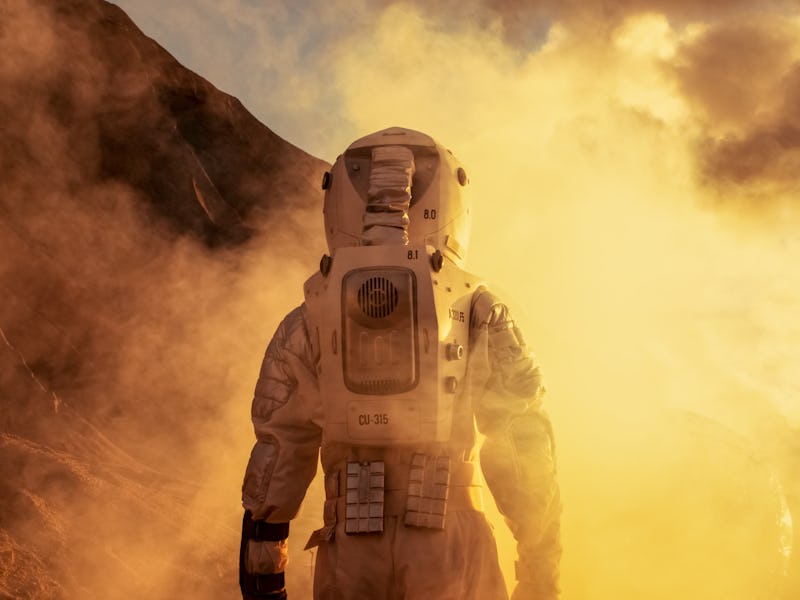Smart gloves will give Mars astronauts the power to control robots
These gloves would allow astronauts to remotely control drones on the surface of Mars.

Even astronauts need a helping hand every now and again, and a new innovation in spacesuit technology from NASA and SETI may be just what they need for missions to succeed on the surfaces of the Moon or Mars.
The group’s smart glove is designed to let astronauts control remote technology like drones with literally just a flick of the wrist. The glove was designed in part with the company Ntention and is inspired by the limited mobility that astronauts currently deal with in their spacesuits thanks to their stiff, pressurized nature. The creation would not only give astronauts back some effective mobility in their gloved fingers but would also enable them to easily control the scouting and reconnaissance of drones in locations they otherwise wouldn’t be able to travel to.
Dr. Pascal Lee, a planetary scientist with the SETI Institute and the Mars Institute, and director of the NASA Haughton-Mars Project at NASA Ames Research Center, tells Inverse that this technology has the potential to be one day adapted for the International Space Station.
“The tech is wireless, so it could apply to operating robotic assets anywhere in space, at least where the robots themselves can survive,” says Lee. “Because it’s a ‘real-time’ interaction, the best applications require that the human operator and robot be within relatively close range to each other…. But yes, we envision astronauts on the ISS or at the Gateway operating a ‘flyer’ this way, in EVA or IVA mode, say to inspect their station.”
This smart glove could help astronauts remotely control technology like drones on the surface of the Moon or Mars
Lee also said in a statement that this technology could help improve the efficiency and productivity of surface missions.
“A smart glove-equipped spacesuit could be a solution,” said Lee. “With it, astronauts could easily control a range of robotic assets, making science and exploration operations on the Moon, Mars and at other destinations more effective and productive”.
The technology works by capturing motions created by a glove-wearing astronaut and converting those to commands that are then wirelessly relayed to the device the astronaut is operating. Sondre Tagestad, system development engineer at Ntention, said in a statement that there is a microcontroller inside the glove and an array of small sensors help make this possible.
“The Ntention smart glove uses a micro-controller to read different kinds of sensors,” said Tagestad. “The sensors capture even subtle motions of the hand and fingers, and wirelessly transfer these to a mobile device that controls the drone or any other robot.”
In addition to the gloves, the astronauts also have the capability of using augmented reality-equipped glasses that enable them to see through the “eyes” of the drone and control its camera by tilting their head.
Not only do these more intuitive human-machine interfaces make it easier for astronauts to interact with and operate these devices, but it also enables them to more easily scout and collect information from the surface of Mars or the Moon without trying to reach those locations on foot and putting themselves at potential risk as a result.
“Astronauts on the Moon or Mars will want to fly drones for various reasons,” said Lee. “For instance, to collect a sample that is out of reach or that needs to be isolated from contamination. Or to assist in a search and rescue operation…. [W]e have been looking with NASA at how robotic flyers might assist astronauts in a variety or science and exploration tasks, including surveying, mapping, sampling, scouting, fetching, and inspecting.”
So far these gloves have been tested at a terrestrial site at Devon Island in the High Arctic, commonly referred to as “Mars On Earth” for the similarities its terrain has to that of the red planet but scientists have high hopes for their applicability to extra-terrestrial settings as well.
And these gloves aren’t the only innovation spacesuits have seen recently. Both NASA and SpaceX released new designs in October for new generation spacesuits that would be more agile and slimmer respectively than previous iterations of suits.
In a statement about the new smart glove technology, NASA and SETI say that they hope to be able to incorporate smart technologies like the gloves into suits for its upcoming Artemis missions to the moon in 2024 and subsequent human-led missions to Mars.
Lee said he has high hopes for the technology, referring to it as close to “magic.”
“When I first saw Ntention’s smart glove in action, I immediately thought of Arthur C. Clarke’s Third Law: ‘Any sufficiently advanced technology is indistinguishable from magic,” said Lee.
The technology has plenty of places to go from here. Lee tells Inverse it could one day support more motions beyond drones.
“We plan to look into how the Astronaut Smart Glove might be switched to operate a robotic arm instead of a drone, to explore additional hand motion technologies,” Lee says.